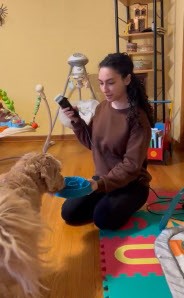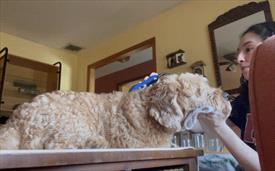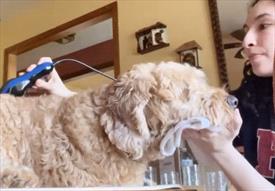12026826 (1).jpg
Jean introduces Doodle to the clippers. Picture courtesy of Jean Tomaselli CVT, KPA CTP, VTS (Habits)
Cooperative care coaching is the artwork of educating animals how to participate in care routines fairly than forcing them to conform. In veterinary drugs, the aim is to assist pets really feel protected throughout care and luxuriate in care routines; due to this fact, pets change into extra treatable sooner or later, not much less. The observe of cooperative care additionally teaches veterinary workers, caregivers, and animal trainers talk successfully with and assist the emotional well-being of the person pet primarily based on that pet’s particular wants and progress. These ideas are core values of Low Stress Dealing with®.
Pets Can Take part in Their Personal Care Routines
Educating pets to participate in care routines must be prioritized over modifying the pet’s habits for different causes, corresponding to obedience coaching.
Fashionable zoos take care of animals, which are sometimes huge, with out resorting to bodily restraint. Think about a giraffe voluntarily stepping onto a large platform to get weighed. Image a tiger presenting his tail via a small window of an enclosure to have a blood pattern taken. For thus many causes, it’s not efficient to repeatedly dart and totally anesthetize these cherished animals each time healthcare is required. Veterinary groups can implement these refined however person–pleasant strategies by prioritizing Low Stress Dealing with®.
That is an thrilling time in veterinary drugs. Practitioners licensed in Low Stress Dealing with® are becoming a member of forces with purchasers, board-certified veterinary behaviorists, and trainers who use optimistic reinforcement strategies. The collaborative aim is to strengthen the human-animal bond by implementing these highly effective cooperative care strategies for the advantage of purchasers and sufferers.
When Pets Say “No” To Care Routines
Cats and canine generally growl or hiss when the veterinarian walks into the room, cower throughout examinations, or attempt to flee on the website of a nail trimmer. Worry can escalate to some extent the place the pet refuses to permit veterinary personnel to the touch them. Pets can change into so fearful, resistant, and defensively aggressive when visiting the veterinarian that the workers runs out of choices to offer care to those sufferers. These pets could then should be referred to board-certified veterinary behaviorists.
It is usually frequent for pets to change into frightened throughout dwelling care routines. One painful or scary expertise, corresponding to publicity to a loud set of clippers, a cleansing of a painful, contaminated ear, or an unintentional clip of a toenail to the short can lead to a pet creating lasting reminiscences of that occasion. Every animal experiences dealing with, restraint, and care in numerous methods. Sensitivity ranges fluctuate amongst pets, with some being extra susceptible to stress and nervousness than others. These pets that present avoidance or resistance throughout care routines at dwelling, in grooming salons, or at animal hospitals are exhibiting indicators of hysteria, concern, or each.
Low Stress Dealing with® veterinary practitioners will do every part they will to offer a pleasurable expertise throughout veterinary care. Your pet’s veterinarian could prescribe short-term, anti-anxiety drugs earlier than scheduled appointments. They might additionally make environmental modifications, corresponding to bringing your pet into the examination room by skipping the busy foyer. The veterinary workforce will deal with pets within the examination room (fairly than “the again”) every time potential. Low Stress Dealing with® practitioners will make certain purchasers are included within the selections being made concerning the pet’s care. When caregivers perceive their pet’s emotional state, it helps everybody make higher selections collectively. It’s crucial to decelerate and understand that persevering with a process with a fearful pet makes the affected person much less treatable sooner or later. Realizing when pets are anxious or frightened is half the battle.
fullsizeoutput_1e6d.jpeg
Picture courtesy of Jean Tomaselli CVT, KPA CTP, VTS (Habits)
fullsizeoutput_1e6f.jpeg
Picture courtesy of Jean Tomaselli CVT, KPA CTP, VTS (Habits)
Cooperative Care Teaches Pets to Say “Sure” to Care Routines
Core Ideas in Cooperative Care:
Emotional well being standing and medicine use. Earlier than educating cooperative care routines, a veterinarian ought to consider a pet’s bodily and emotional well being. Some sufferers are just too anxious to study. Drugs may be useful in creating a snug place to begin by relieving the pet’s nervousness sufficient to permit them to take part and obtain meals for counterconditioning.
Veterinarians could prescribe drugs to cut back general nervousness or situational drugs meant to be used earlier than annoying occasions, and generally each. Utilizing a number of drugs might help to keep away from the sedating results that will include a bigger dose of a single remedy. Moreover, many pets could require short-term anesthesia for veterinary care or grooming till they are often efficiently retrained via cooperative care routines.
Physique Language. Every species of animal communicates with their very own distinctive physique language. Decoding what pets are speaking with their physique language doesn’t come naturally to most individuals. Your Low Stress Dealing with® Licensed veterinary practitioner can information you to the suitable skilled who might help you interpret your pet’s physique language. These professionals embrace board-certified veterinary behaviorists (DACVB), board-certified veterinary technician specialists in habits (VTS), and progressive optimistic reinforcement trainers who’ve a detailed affiliation with the veterinary habits neighborhood. Trainers who use any type of punishment or advocate prong or shock collars, choke chains, and so on., must be averted. These strategies break down the human-animal bond and probably intensify concern and concern aggression.
Prevention. Resilience conditioning is outlined as supporting a person’s capability to recuperate from stress. If younger pets show sensitivity to being touched, throughout routine dealing with, it’s time for intervention and altering the method to enhance their capability to recuperate from stress. Help and company are core ideas in each resilience conditioning and cooperative care.
Low Stress Dealing with® veterinary practitioners have a vital accountability to assist every affected person’s resilience for future care occasions. That is achieved by offering predictability, social assist, and company throughout veterinary care. For instance, kittens would possibly lick child meals off a lick mat throughout procedures, puppies may be educated to face on a platform for treats whereas present process a delicate examination, and any non-essential remedies must be postponed if a affected person exhibits indicators of being overwhelmed. Every time cooperative care routines are practiced with puppies and kittens, they begin to keep in mind that veterinary visits are protected and predictable.
Veterinarians and veterinary technicians are integral in preserving the human-animal bond (HAB). This bond can deteriorate when purchasers battle to take care of pets at dwelling or when veterinary professionals can not successfully deal with sufferers who’ve change into fearful or harmful. A easy but efficient safety measure is to repeatedly feed a pet or kitten all through their veterinary expertise. This method helps these younger pets develop resilience and reduces concern in care contexts.
By progressively introducing pets of all ages to dwelling and veterinary care routines and by pairing these routines with high-value meals and different nice experiences, pets discover pleasure in care procedures. When pets keep in mind these experiences as satisfying, they need to do these actions once more.
Vital Tip: The frequency of treats throughout cooperative care is steady at first, 10 to fifteen per minute. The treats must be pea-sized and delicious.
Focusing on and Stationing. Focusing on and stationing are invaluable strategies for coaching animals to take part willingly of their care. Focusing on entails coaching an animal to direct a particular physique half, or their total physique, towards a delegated level or object. This methodology may be utilized to varied animals and for various functions. As an example, a parrot could also be educated to focus on their wing into an individual’s palm for feather inspection or a canine may be taught to the touch their nostril towards a wall and stand nonetheless for a brief veterinary examination.
The observe of concentrating on behaviors paired with optimistic reinforcement (e.g., meals) for every repetition helps to make concentrating on and the goal object protected and predictable for the animal. For instance, if a canine is taught to focus on the within of a basket muzzle with their nostril, the muzzle turns into a well-recognized and non-threatening object. This precept may be prolonged to quite a lot of grooming and veterinary instruments.
Stationing is a method intently associated to concentrating on and is especially helpful in educating animals to remain at a particular location for an prolonged interval. This idea is very efficient in varied settings and for various species. As an example, a horse can study to station themselves in a selected spot for voluntary grooming and veterinary care, eliminating the necessity for restraints like cross ties. Equally, a canine may be taught to face on a yoga mat for dwelling care routines, and this mat can then be delivered to the veterinary clinic to offer a well-recognized and comforting setting. Cats may be educated to leap onto a pedestal to obtain oral remedy, making the method smoother and fewer annoying for the cat and the caregiver.
Alternative, management, and consent. In conventional pet care or therapy strategies, animals usually don’t have any say within the course of, which may be complicated and horrifying for them as they don’t perceive the intentions behind these actions. Nevertheless, trendy strategies in animal care are altering this dynamic. These strategies contain speaking intentions to the animals and educating them to precise “sure” or “no” to their care.
This method of permitting pets, zoo animals, wildlife, and livestock to consent to or deny their very own care has proven shocking outcomes. Opposite to the idea that when given a alternative, pets would say “no” on a regular basis, the other is usually true. The extra we acknowledge their “no” the extra they start to say “sure”. They start to interact of their care routine.
Begin Buttons. Begin buttons are an revolutionary idea in animal husbandry and a key aspect in cooperative care routines, emphasizing the significance of animal consent and autonomy. By observing and reinforcing animals with meals as they show pure and cozy behaviors, these behaviors may be inspired and, due to this fact, extra often provided. The idea is to show the animal to current these behaviors as a sign to provoke a care routine, successfully giving them a “begin button” speaking that they’re prepared to start out their care routine.
This methodology is being utilized throughout varied species. As an example, horses may be taught to nod their heads to speak you can begin brushing them. Canine may be educated to relaxation their chin on a towel to point readiness for dwelling care and to raise their chin as a sign of discomfort or the necessity to cease.
When a pet stops providing their begin button habits, they’re withdrawing their lively participation within the care routine, speaking a “no” or “I would like a break.” The extra a caregiver acknowledges when a pet says “no”, the extra snug and fewer fearful or defensively aggressive the animal turns into in future care conditions.
By empowering pets with the management to start out and cease their very own care routines at will, caregivers are offering their pets with autonomy. This observe not solely improves the animal’s expertise throughout care routines but additionally strengthens the belief and communication between the pet and their caregiver, enhancing the general high quality of care and the human-animal bond.





